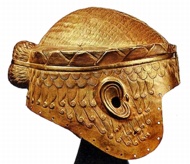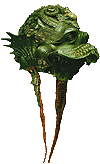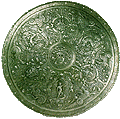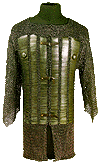
 arms and armor or arms and armour - Weapons and defensive gear, including helmets
and entire suits of armor, equestrian
equipment, swords and daggers, polearms, firearms, shields, and
other accessories. Such objects
may project power, wealth,
and splendor, as much as the dangers of their use. Among the artists
who have made designs and decorations
for arms and armor are Leonardo da Vinci (Italian, 1452-1519)
and Albrecht Dürer (German, 1471-1528).
arms and armor or arms and armour - Weapons and defensive gear, including helmets
and entire suits of armor, equestrian
equipment, swords and daggers, polearms, firearms, shields, and
other accessories. Such objects
may project power, wealth,
and splendor, as much as the dangers of their use. Among the artists
who have made designs and decorations
for arms and armor are Leonardo da Vinci (Italian, 1452-1519)
and Albrecht Dürer (German, 1471-1528).
"Armor" is the American spelling. "Armour" is the British spelling.
Examples of arms and armor:

Mesopotamia, Royal Cemetery at Ur, Helmet of King Meskalamdug, c. 2400 BCE, repoussé gold, height 22 cm, greatest diameter 26 cm. The decoration of the helmet simulates the king's crown, hair, and ears. Holes drilled along the lower edges enabled the attachment of an inner helmet. This is one of many Mesopotamian objects that have recently been lost or stolen from Iraq's museums and have yet to be recovered. The Oriental Institute of the U of Chicago has posted a database of treasures that have been lost or stolen from Iraq.

Greece, Cretan, Two helmets, late 7th century BCE,
Archaic, bronze, height
of helmet with horses and lions 9 5/8 inches (24.5 cm), height
of helmet with winged youths 8 1/4 inches (21 cm), Metropolitan
Museum of Art, NY.
Japan, Helmet, 5th century CE, Kofun period, iron, covered with copper-gilt, height 8 1/2 inches (21.6 cm), Metropolitan Museum of Art, NY.

Ostrogothic, Helmet (Spangenhelm), 6th century CE,
bronze-gilt,
iron, height
7 1/2 inches (19.1 cm), Metropolitan Museum of Art, NY.

Europe (possibly Scandinavian), Sword, 10th century, steel, copper,
silver, length 37 3/4 inches (96 cm),
Metropolitan Museum of Art, NY.

France or Spain (Catalonia), Rowel Spur, c. 1400, copper,
enameled and gilded, length
7 1/4 inches (18.4 cm), Metropolitan Museum of Art, NY.
![]()
Japanese, Long sword (katana) inscribed by
Sukemitsu of Bizen (Japanese), Short sword (wakizashi) attributed
to Yasumitsu (Japanese), Blades for a Pair of Swords (Daisho);
long sword: dated 1440, short sword 15th century, Muromachi
period, steel; Short sword (wakizashi): 20 3/4 inches (52.1
cm); Long sword (katana): 25 1/4 inches (64.3 cm), Metropolitan
Museum of Art, NY.

Germany, Tournament Shield (Targe), c. 1450, wood, leather, linen,
gesso, polychromy,
silver, 22
x 16 inches (56 x 40.5 cm), Metropolitan Museum of Art, NY. See
heraldry.

Iran, Helmet, late 15th century, Ak-Koyunlu/Shirvan
period, steel, engraved
and damascened with silver,
length 13 3/8 inches (34
cm), Metropolitan Museum of Art, NY.

Kolman Helmschmid (German, 1471-1532, Augsburg),
Portions of a Costume Armor, c. 1525,
steel, embossed,
etched, and gilded,
Metropolitan Museum of Art, NY.

Turkey, Helmet, mid-16th century, Ottoman Period,
steel, damascened
with gold,
height 10 3/4 inches, Metropolitan
Museum of Art, NY.
Turkey, Saber, 16th century, Ottoman period, steel, inlaid with gold; precious stones, fish skin, length 37 7/8 inches (96.1 cm), Metropolitan Museum of Art, NY.

England, Royal Workshops, Greenwich, Armor for Field and Tournament, 1527,
steel, etched
and gilded overall, length
73 inches (185.5 cm), Metropolitan Museum of Art, NY.

Italy, Milan, Parade Helmet, 1540-1550, Hermitage Museum,
St. Petersburg, Russia.

Paris (?), Parade Shield, 1540-1550, Hermitage Museum,
St. Petersburg, Russia.

Filippo Negroli (Italian, c. 1510-1579, Milan),
Burgonet, 1543, steel, embossed
and damascened with gold,
height 9 1/2 inches (24.1
cm), weight 4 lb. 2 oz.
(1.9 kg), Metropolitan Museum of Art, NY.
Peter Peck (German, 1500/10-1596, Munich), Double-Barreled Wheellock Pistol of Emperor Charles V, c. 1540-45, steel, etched and gilded, wood, inlaid with engraved staghorn, length 19 3/8 inches (49.2 cm), Metropolitan Museum of Art, NY.

Japan, Helmet (Zukinnari Kabuto), 16th century,
Momoyama period, lacquered iron, height
16 1/8 inches (41 cm), Metropolitan Museum of Art, NY. See Japanese art.

Michel Witz the Younger (Austrian), Three-quarter
armor for a nobleman, made in Innsbruck c.1550, Steiermärkisches
Landesmuseum Joanneum, Graz, Austria. Michel Witz applied a niello decoration
all over this armor
to achieve a Baroque
black and white design with grotesque
masks on shoulders,
elbows and knees, along with foliate
motifs everywhere else. In addition, the armor has been embossed
in part, a process whereby
the metal was hammered
and raised from within,
producing a relief
on the outside.

France, after designs by Etienne Delaune
(1518/19-1583, Paris), Armor for Henry II of France, c. 1555,
steel, embossed,
blued, silvered, and gilded, height
74 inches (188 cm), weight
53 lb. 4 oz. (24.2 kg), Metropolitan Museum of Art, NY.

France, Paris, probably after designs by
Etienne Delaune (1518/19-1583), Shield of Henry II of France, c. 1555,
steel, embossed
and damascened with gold
and silver,
height 25 inches (63.5 cm),
weight 7lb. (32.2 kg), Metropolitan
Museum of Art, NY.

France, Paris, Burgonet with Falling Buffe, c. 1555,
steel, blued
and gilded, height
14 inches (35.5 cm), weight
5 lb. 6 oz. (2.4 kg), Metropolitan Museum of Art, NY.
"El Greco", Domenico Theotocopoulos (Greek-Spanish, 1541-1614), Vincenzo Anastagi, between c. 1571 and 1576, oil on canvas, 74 x 49 7/8 inches (188 x 126.7 cm), Frick Collection, NY. He wears his cuirass (breastplate) and sword, and stands near his helmet. Vincenzo Anastagi (c. 1531-86) was born in Perugia. He joined the Knights of Malta in 1563 and was a leader in the heroic defense of that island during the massive Turkish siege of 1565. After holding various other responsible posts he was named Sergeant Major of Castel Sant'Angelo in Rome. Anastagi apparently was an expert on fortifications.

England, Royal Workshops, Greenwich, Armor of George Clifford, Third Earl of Cumberland,
c. 1580-85, steel,
etched,
blued, and gilded,
height 69 1/2 inches (176.5
cm), weight 60 pounds (27.2
kg), Metropolitan Museum of Art, NY.

Germany (probably Nuremberg), Tournament Book, late 16th century, pen and colored wash
on paper, Metropolitan Museum of
Art, NY.

Russia, Moscow Armoury workshops (?), Hauberk Half Armour, or Bakhterets,
late 16th- early 17th centuries, Hermitage Museum, St. Petersburg,
Russia.

Hilt by Israel Schuech Dresden (German, active
c. 1590-1610, Dresden), Blade by Juan Martinez (Toledo, Spain),
Rapier of Prince-Elector Christian II of Saxony,
1606, steel, bronze-gilt
with traces of enamel,
paste jewels, cameos, pearls,
length 48 inches (122 cm),
Metropolitan Museum of Art, NY.

Drouar (possibly André Drouart) (French,
Paris), Armor of Infante Luis, Prince of Asturias,
1712, steel, blued and gilded;
brass-gilt; silk; cotton;
metallic yarn; paper; height
28 inches (71.1 cm), Metropolitan Museum of Art, NY.

Myochin Muneakira (Japanese, 1673-1745),
Mask, 1745, Edo
period, lacquered iron, height
9 1/2 inches (24.1 cm), Metropolitan Museum of Art, NY. See Japanese art
and mask.

Ivan Lyalin (Russian, Tula), Flintlock Pistol, c. 1790, Hermitage
Museum, St. Petersburg, Russia.
![]()
American?, Beltknife, c. 1750-1850?, helically
carved wooden
handle with a wave-shaped steel
blade, formerly the Tom Wnuck collection, Rochester, NY, until
sold in 2003.

Japan, Samurai Armor, Victoria and Albert Museum,
London. See Japanese
art.

Jacob Kuntz (American, 1780-1876, Philadelphia),
"Kentucky" Flintlock Rifle,
c. 1810-15, steel,
maple, brass, silver, bone, horn,
length 59 1/4 inches (150.5
cm), Metropolitan Museum of Art, NY.

France, Costume Armor, c. 1780-90, Metropolitan
Museum of Art, NY. This Greco-Roman style
armor is typical of costumes
made across Europe from the Renaissance to the late Baroque periods for tournaments, ballets,
and other court pageants. See theater.

Sudan, Turkiya (period of Turco-Egyptian rule), Horseman's Chainmail Tunic, 1820-81, reused during the Mahdiya, 1881-98, butt-joint wire rings, with no evidence of an organic lining, Sudan National Museum.

Sudan, Helmet, 19th century, gilded steel, chainmail and textile, Sudan National Museum. See Islamic art.

Geurk Elizarashvili (Russian, Georgia), Hunting Dagger, 1846, Hermitage Museum,
St. Petersburg, Russia.

Samuel Colt (American, 1814-1862, inventor
and manufacturer, Hartford, CN), and Gustave Young (1827-1895,
engraver), Colt Third Model Dragoon Percussion Revolver,
c. 1853, Metropolitan Museum of Art, NY. See engraving.

Nikolaj Goltyakov (Russian, Tula), Rifle
(fragment), 1875-1880,
Hermitage Museum, St. Petersburg, Russia.

Kaipel Ka (Wahgi people, Western Highlands Province, Papua New Guinea, contemporary), Shield, 1980s, painted metal, British Museum, London. "When inter-group warfare recommenced in the 1980s, people in the Wahgi area of the Highlands of Papua New Guinea started making fighting shields after a gap of fifty years." The metal used by these armorers came from auto bodies and metal drums.
![]()

Antonio Riello (Italian, 1958-), Mathilde, 2000, an assisted readymade grenade. Artist's statement: "In 1998 I decided to focus my artistic research mainly about a
'fashion-fiction' visual story regarding an old passion of mine: weapons -- objects full of symbolic senses. I want to mix, in an artistic way, traditional 'female stuff' like fashion with very traditional 'male stuff' like guns. It consists in a restyling of real military weapons into fashion items for ladies . . . . . Using leopard skins, brightly lacquered colors, inset jewels and fake furs, I create a range of specialized items for wives of mafia bosses, arms dealers, sophisticated ladies and exigent soldiers . . . hybrids born from Italian obsession for high fashion as well as for violence." See irony and more of Riello's hybrids.
Also see basketry, heraldry, horn, Middle Ages, omphalos, and Renaissance.
https://inform.quest/_art
Copyright © 1996-![]()